Affiliate links on Android Authority may earn us a commission. Learn more.
Google Pixel Buds Pro vs Pixel Buds A-Series: Which buds are best?
Published onJuly 12, 2023



Google may have started as a search engine, but almost three decades later and it’s expanded into audio products. Today, the Google Pixel Buds Pro offer everything but the kitchen sink. Then, there are the simplified Google Pixel Buds A-Series. These earbuds have a more reasonable price and forgo fancy accouterments.
We’ll compare the Google Pixel Buds Pro to the Google Pixel Buds A-series to give you an idea of which wireless earbuds are best for you. We even include a list of Pixel Buds alternatives, for listeners who aren’t quite satisfied with Google’s options.
Google Pixel Buds Pro vs Pixel Buds A-Series: At a glance
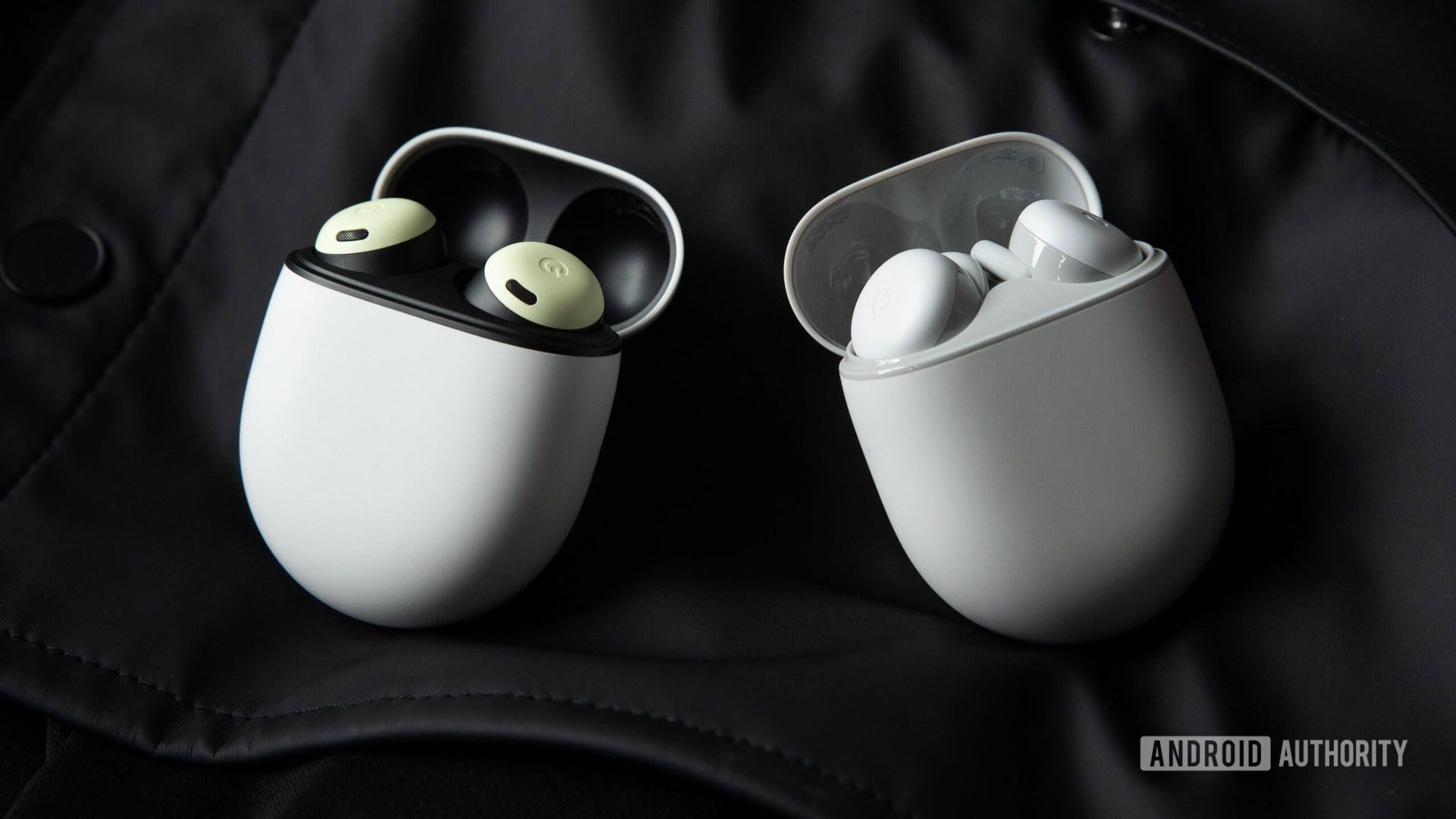
Google released the Pixel Buds Pro on July 28, 2022. A little over a year prior, it released the Pixel Buds A-Series on June 17, 2021. These earbuds share plenty of similarities. Noise canceling and spatial audio are the main differentiating factors between Google’s buds.
Using a similar design, the Pixel Buds A-Series and Pixel Buds Pro have large, circular touch panels adorned with Google’s “G” logo. Google uses a sealed design with ear tips for both of these earbuds. Both Google earbuds come with small, medium, and large ear tips.
Google’s Pixel Buds both merit an IPX4 water-resistant rating, making them durable enough for working out. Athletes who engage in vigorous exercise may opt for the cheaper A-Series earbuds. These feature permanent wing tips that further cement them to your ears. Google ditched the winged design for its Pro buds. Larger earbud housings accommodate the Pixel Buds Pro’s myriad sensors.
ANC makes the Pixel Buds Pro more premium than the Pixel Buds A-Series. Both earbuds’ ear tips block ambient noise, but the Pixel Buds Pro will hush the sounds of engines and rumbles during your commute or plane ride. Unlike the Pixel Buds A-Series, the Pixel Buds Pro have spatial audio with head tracking. The Pixel Buds Pro are more advanced, but the A-Series hold their own, too.
We expect the next Pixel Buds Pro firmware update will include Clear Calling to optimize call quality. This feature affects the quality of the person on the other end of the call and filters out their end’s background noise while enhancing their vocal clarity. The earphones should also receive “super wide band speech,” which will improve the 16-32kHz range.
The Google Pixel Buds Pro cost $199, and the Pixel Buds A-Series cost $99. Both sets of earbuds go on sale throughout the year for $149 and $79, respectively.



Are the Google Pixel Buds Pro and Google Pixel Buds A-Series worth buying?
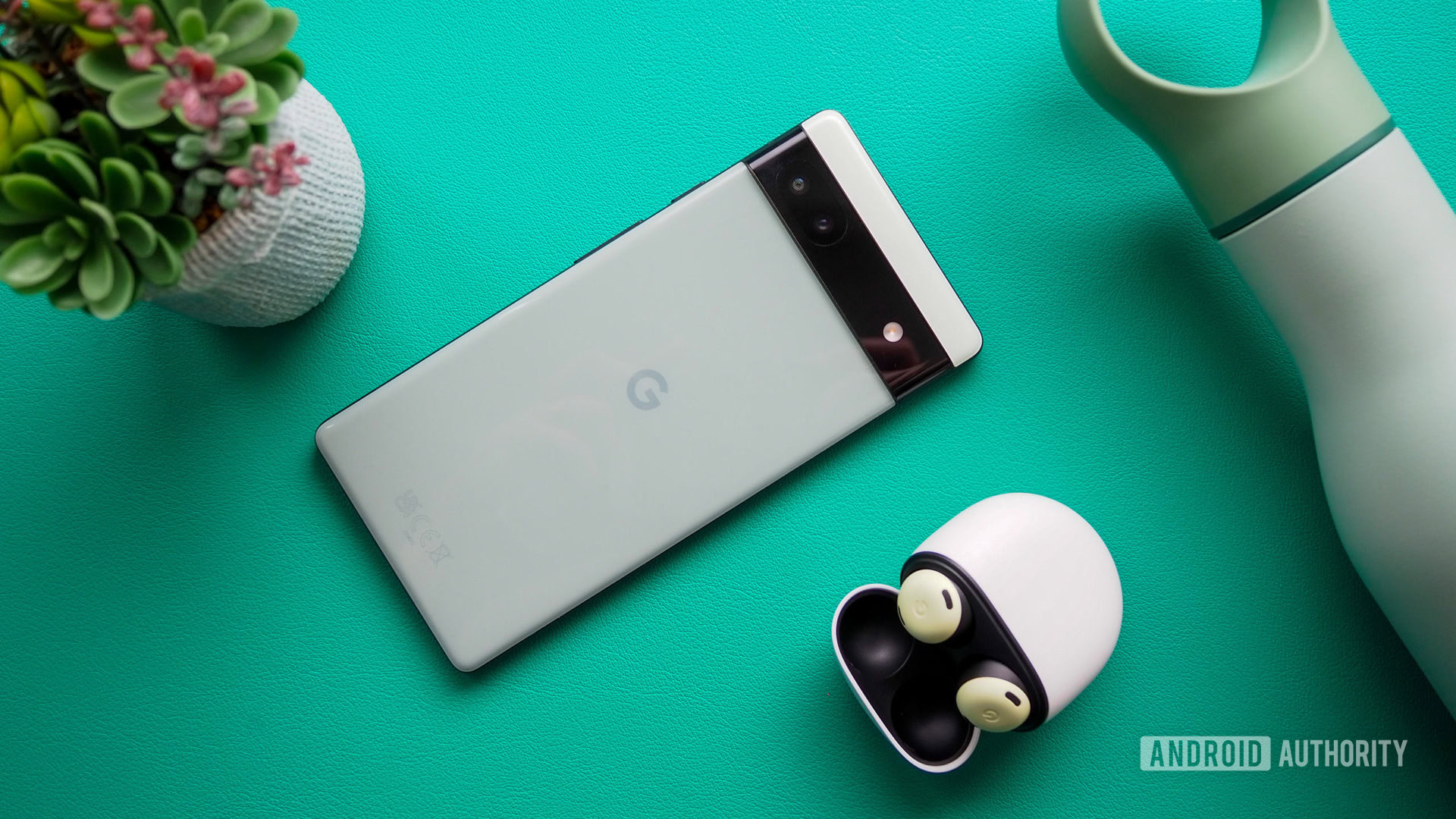
I recommend buying the Pixel Buds Pro over the A-Series if you’re starting from scratch. The Pro are excellent earbuds for Android phone owners and even better for Pixel 6 or 7 phones. You can access a custom EQ and audio switching between devices when paired with an Android phone. Pairing these to a Pixel 6 or 7 phone opens the door for spatial audio with head tracking.
Other features that make the Pixel Buds Pro stand out from the crowd are Bluetooth multipoint and active noise canceling. This is a winning combo for productivity. You also get a water-resistant wireless charging case with an IPX2 rating. The earbuds have an even more impressive IPX4 rating, making them good for exercise. That said, I didn’t find the Pixel Buds Pro fit as comfortably as the Pixel Buds A-Series.
Listeners who don’t care for ANC or spatial audio may want to save some money and get the Pixel Buds A-Series instead. More pedestrian in their feature set, the Pixel Buds A-Series have a lighter build and stabilizing wing tips. Like the Pixel Buds Pro, you get touch controls and IPX4 water-resistant earbuds.
When buying a set of Google Pixel Buds, you receive whimsical hardware and useful updates during their lifetime.
Without wireless charging or water resistance, the Pixel Buds A-Series case requires a USB-C cable to recharge. Like the Pixel Buds Pro case, the A-Series case is sturdy and feels like a fidget toy. When you close it, the case rattles off a satisfying click sound.
Both the Pixel Buds A-Series and the Pixel Buds Pro work with Google Assistant. You can say, “Hey, Google” with either set of buds for sending texts and making inquiries. Both pairs of Pixel Buds also work with Google’s Find My Device and Google Translate apps. The former lets you emit a sound through either earbud or locate the earbuds’ last-known location on a map.
Google’s earbuds punch above their price points, and their regular firmware updates make them distinguished. In the past, Google has released firmware and software updates to add utility to the earbuds. We saw this with the Pixel Buds Pro when the company introduced a custom EQ. Likewise, Google fixed the Pixel Buds A-Series’ initial low-volume issue and added a bass boost slider. Admittedly, we would have liked to see these features upon release. Receiving additional features down the line is the next best thing. It shows that Google is willing to improve its products and listen to customers.
What experts are saying about the Google Pixel Buds Pro and Google Pixel Buds A-Series

After reviewing both of Google’s Pixel Buds, it’s clear that these are powerful earbuds for Android. Each pair of Pixel Buds come at a fair price, given their features. Only iPhone owners should stay away from these earbuds; Google’s features are as closed off to iOS as Apple’s are to Android.
Google threw everything into the Pixel Buds Pro, and it paid off. We commended Google for its effective noise canceling and transparency listening modes. Further, the battery life is exceptional, given the demanding nature of good ANC. Curious listeners will enjoy playing around with the Pixel Buds app’s five-band EQ. Meanwhile, less adventurous folks will feel satisfied with the default sound.
Those who rely on creature comforts like multipoint and audio switching will feel at home with the Pixel Buds Pro. The company even added modern features like spatial audio and head tracking. The $199 original price isn’t too shabby either.
You don’t get swanky spatial audio with the A=Series. Instead, you get earbuds that focus on the basics. The Pixel Buds A-Series fit well and have great touch controls. Out of the box, the A-Series lack bass, but enabling Bass Boost actually makes them sound a tad better than the Pro. While we don’t like the Adaptive Sound feature, we appreciate the option to disable it.
What other reviewers from around the web think
To give you an overview of the Google Pixel Buds Pro and A-Series, we’re sharing what other reviews are saying about the earbuds.
- Tom’s Guide’s Alex Bracetti said the Pixel Buds Pro’s ANC removes low-frequency sounds. Simultaneously, the buds make it hard to hear higher-pitched sounds like birds chirping. He said the Pixel Buds Pro are great noise canceling earbuds for Android users in need of a great Google Assistant experience.
- Digital Trend’s Simon Cohen said the Pixel Buds Pro are compact earbuds that fit well and offer good sound quality. He remarked that the absence of high-quality codecs like aptX and LDAC was disappointing.
- Gizmodo’s Sam Rutherford noted the A-Series’ comfortable design and compact charging case but wasn’t impressed with the battery life. He said the A-Series are good and affordable earbuds for anyone using an Android phone.
Google Pixel Buds Pro vs Pixel Buds: Specs
| Google Pixel Buds Pro | Google Pixel Buds A-Series | |
|---|---|---|
Dimensions | Google Pixel Buds Pro Earbud: 23.7 x 22.3 x 22mm Case: 63.2 x 50 x 25mm | Google Pixel Buds A-Series Earbud: 29.3 x 20.7 x 17.5mm Case: 63 x 47 x 25mm |
Weights | Google Pixel Buds Pro Earbud: 6.2g Case: 56.2g | Google Pixel Buds A-Series Earbud: 5.1g Case: 42.5g |
Bluetooth connectivity | Google Pixel Buds Pro Bluetooth 5.0 SBC, AAC | Google Pixel Buds A-Series Bluetooth 5.0 SBC, AAC |
Water resistance | Google Pixel Buds Pro Earbuds: IPX4 Case: IPX2 | Google Pixel Buds A-Series Earbuds: IPX4 Case: None |
Battery life | Google Pixel Buds Pro Earbuds, ANC on: 7 hours Case and earbuds, ANC on: up to 20 hours Earbuds, ANC off: 11 hours Case and earbuds, (ANC off): 20 hours | Google Pixel Buds A-Series Earbuds: 5 hours Case and earbuds: 24 hours |
Charging | Google Pixel Buds Pro USB-C Qi wireless | Google Pixel Buds A-Series USB-C |
Audio hardware | Google Pixel Buds Pro 11mm custom dynamic drivers Pressure relief vents Wind-blocking mesh covers | Google Pixel Buds A-Series 12mm custom dynamic drivers Pressure relief vent |
Mics and sensors | Google Pixel Buds Pro Three mics per earbud Voice accelerometer Touch capacitive sensors IR proximity sensor Motion detecting accelerometer and gyroscope | Google Pixel Buds A-Series Dual beamforming microphones Touch capacitive sensors IR proximity sensor Motion detecting accelerometer |
Spatial Audio with head tracking | Google Pixel Buds Pro Yes, requires Google Pixel 6 series or Pixel 7 series running Android 13+ | Google Pixel Buds A-Series No |
Noise-cancelling | Google Pixel Buds Pro Yes | Google Pixel Buds A-Series No |
Transparency | Google Pixel Buds Pro Yes | Google Pixel Buds A-Series Yes |
Ear tip selection | Google Pixel Buds Pro S, M, L | Google Pixel Buds A-Series S, M, L |
Compatibility | Google Pixel Buds Pro Any Bluetooth 4.0 device (Android/iOS) Full compatibility: Android (6.0 or later) Google Account Google Assistant enabled phone Internet connection | Google Pixel Buds A-Series Any Bluetooth 4.0 device (Android/iOS) Full compatibility: Android (6.0 or later) Google Account Google Assistant enabled phone Internet connection |
Colors | Google Pixel Buds Pro Coral Fog Charcoal Lemongrass | Google Pixel Buds A-Series Clearly White Dark Olive Charcoal |
Release date | Google Pixel Buds Pro July 28, 2022 | Google Pixel Buds A-Series June 17, 2021 |
Price | Google Pixel Buds Pro $199 | Google Pixel Buds A-Series $99 |
Google Pixel Buds Pro vs Pixel Buds performance
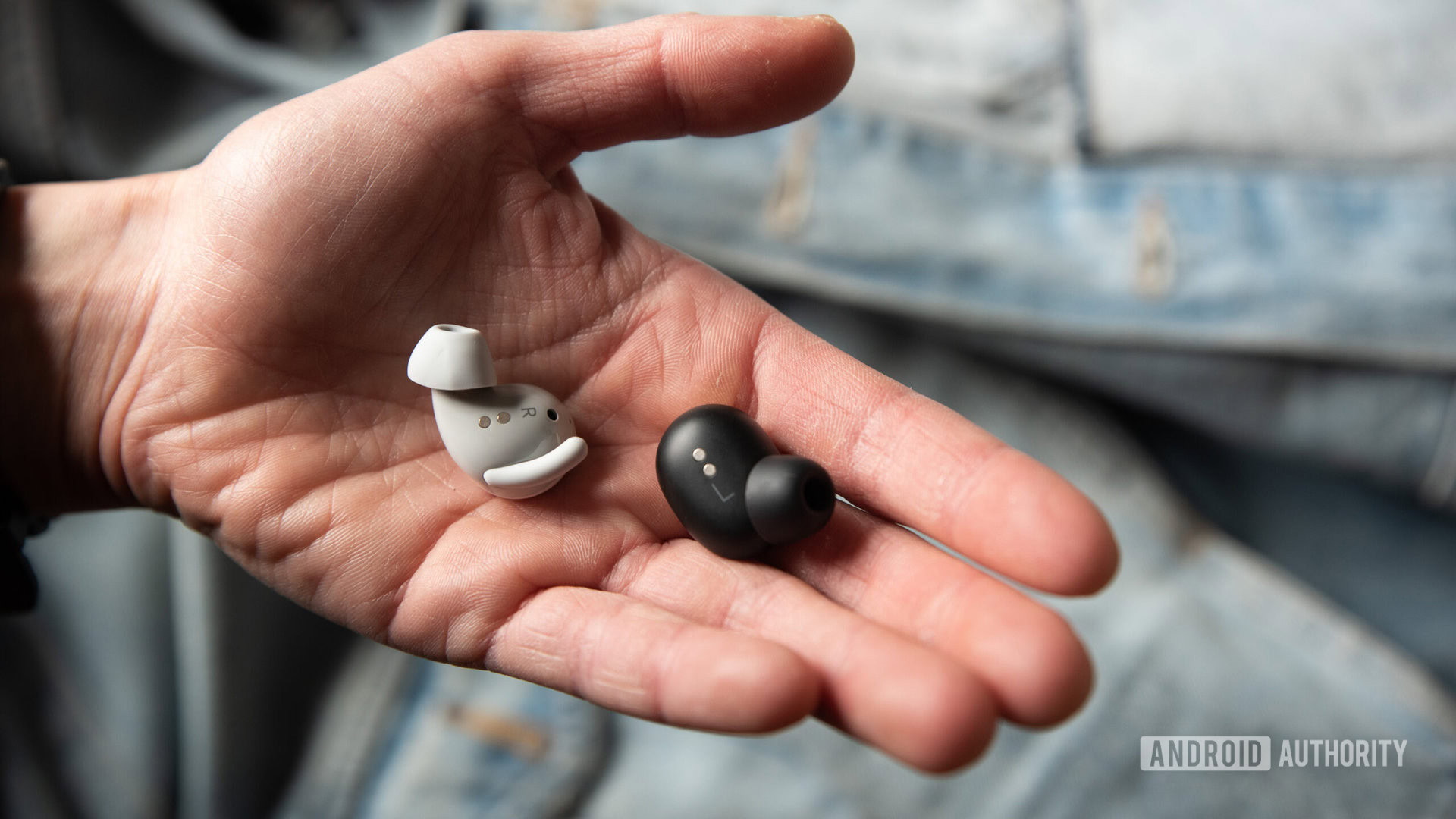
The Pixel Buds Pro and Pixel Buds A-Series look like fraternal twins and provide fraternal experiences. As expected, both buds support Google Fast Pair for one-step pairing to any Android phone. You can be up and listening to music or podcasts with either of the Pixel Buds in seconds.
Audio switching and Bluetooth multipoint take connectivity one step further on the Pixel Buds Pro. With audio switching, you may watch a movie on a laptop and receive calls from any device under the same Google account as your Pixel Buds. Further, you can actively connect to two specific devices at once with multipoint. These devices don’t have to be under the same Google account as your Pixel Buds. Little conveniences like these may not make or break the experience, but they do improve it.
Bluetooth 5.0 powers the Pixel Buds Pro and A-Series. Both sets of Google earbuds only stream audio over the SBC and AAC Bluetooth codecs. Since AAC performance has historically varied on Android, not all Android phones will send consistent, high-quality audio. When reviewing both earbuds, I noticed audio-visual lag when streaming videos over AAC.
Unlike the Pixel Buds A-Series, the Pixel Buds Pro have a Volume EQ. This adjusts the bass and treble as the volume changes. Google’s Volume EQ should make music sound more consistent across volume levels, but it won’t transform your buds into Hi-Fi cans.
Replete with a five-band Custom EQ, ear tip fit test, and spatial audio, the Pixel Buds Pro are the more powerful earbuds. Even so, we appreciate the Pixel Buds A-Series for their stripped-down experience and price.
How does Spatial Audio work on the Pixel Buds Pro and A-Series?
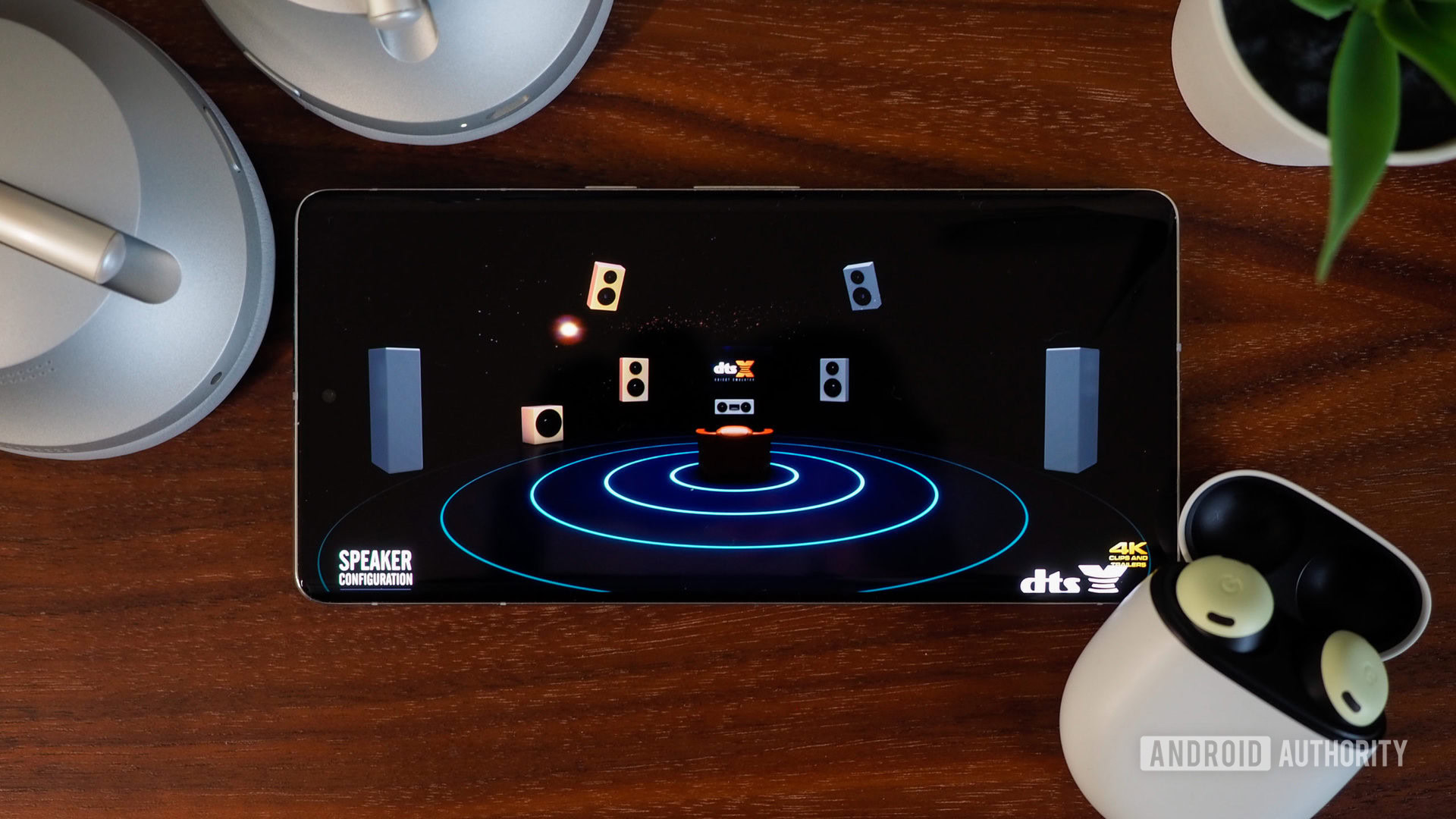
Google’s spatial audio creates a virtual field of 360-degree sound. Think of it as advanced surround sound that truly puts you at the center of a film or music. The effect: you’ll hear the audio twist around you as the pilot on screen does a barrel roll to avoid oncoming attacks.
With a Pixel 6 or Pixel 7 series phone and the Pixel Buds Pro, you can enable head tracking. With this turned on, the audio is anchored to the compatible Pixel phone. As you move your head relative to the phone, the audio changes. With the phone in front of you, turning your head to the right will make sound louder through the left Pixel Buds Pro earbud.
To use this feature, you’ll need the Google Pixel Buds Pro (firmware version 4.30 or later) and a Google Pixel 6, Pixel 6 Pro, Pixel 7, or Pixel 7 Pro smartphone running Android 13 or later. It requires Dolby Atmos or DTS-X content with the EC-3 codec to work. Oh, and you’ll need one of these apps: Disney Plus, Google TV, HBO Max, Netflix, or YouTube. Got all that?
The Pixel Buds A-Series don’t have all the sensors that facilitate head tracking, but you can enjoy spatial audio from certain music streaming services.
Google Pixel Buds Pro vs Pixel Buds A-Series: Noise canceling and isolation
If you spend too much time on public transit or flying for work, the Pixel Buds Pro are the better earbuds for you. Noise canceling from the Pixel Buds Pro will make your neighbor’s lawnmower or a persistent wind about 85% quieter than without the earbuds. This impressive performance won’t affect the battery life too much, either. At the same time, silicone ear tips keep out most of your environment’s high-pitched sounds.
Good noise canceling comes at a cost, though. If you think the Pixel Buds A-Series will do enough to block background noise without ANC, more power to you. The passive isolation quiets high frequencies by about 75-85%, which is great. The A-Series just don’t do much to reduce the loudness of low-pitched sounds.
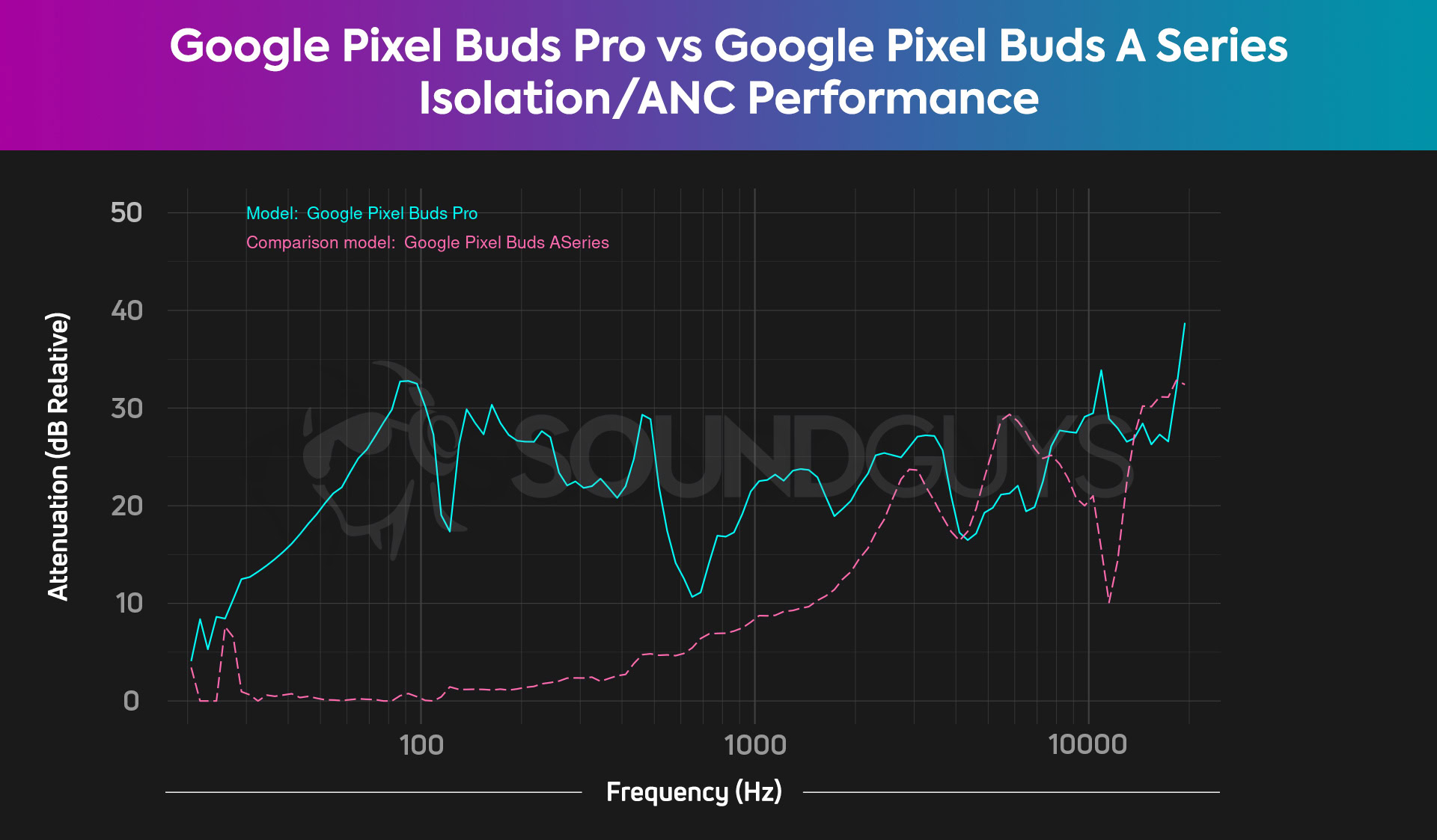
Look at the noise canceling comparison chart above. This visualizes how much more noise the Google Pixel Buds Pro block out compared to the Pixel Buds A-Series. The higher the line is, the more noise the earbuds block out for that specific frequency. The frequency ranges from 0-256Hz, and 257-2,040kHz are the most important for isolation. As you can see, the Pixel Buds A-Series don’t start significantly blocking out noise until about 1,000Hz. Meanwhile, the Pixel Buds Pro reduce almost all sounds to a perceptible degree.
Do the Google Pixel Buds Pro sound better than the Pixel Buds A-Series?
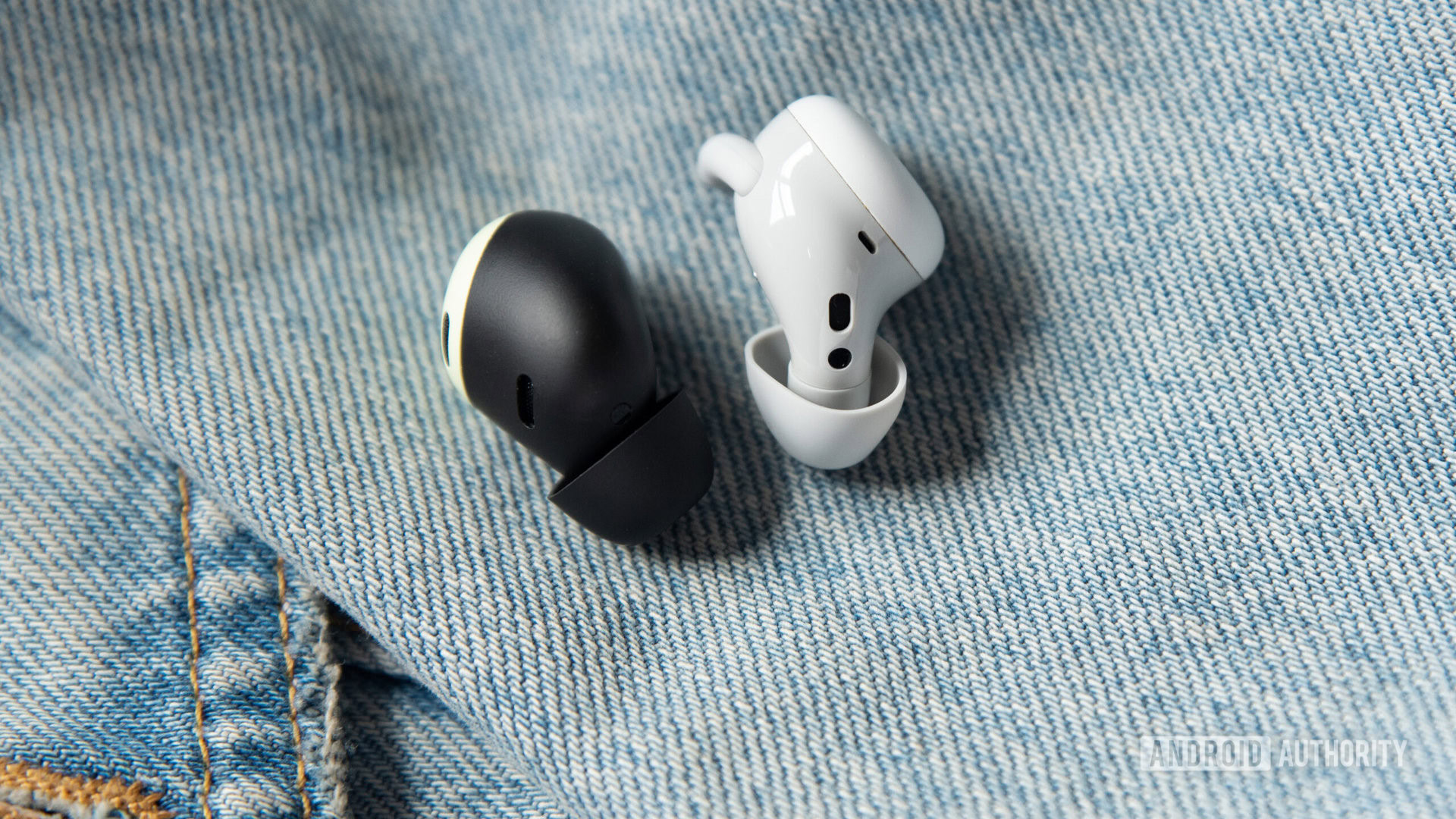
The default sound of the Pixel Buds Pro is much better than the Pixel Buds A-Series’, but both earbuds have their audio quirks. Choosing between the two forces the question: to have too much bass or not enough?
The Google Pixel Buds Pro boost bass quite a bit. This sound profile bodes well for hip-hop, electronic, and pop music, but makes it hard to hear vocals during particularly crowded parts of a track. On the other end of the spectrum, emphasized treble can make violins and flutes sound too loud. Even still, most will prefer the Pixel Buds Pro’s out-of-the-box sound. In contrast, the Pixel Buds A-Series make sub-bass and bass too quiet. You won’t feel a kickdrum’s thud through the A-Series like you will through the Pro earbuds.
To improve the Pixel Buds Pro's sound, play with the custom EQ. Enabling the Pixel Buds A-Series' Bass Boost EQ dramatically improves the sound, too.
Fortunately, listeners can customize the sound of Google’s earbuds to some degree. With the Pixel Buds Pro, listeners can create a custom EQ to tailor the sound. Android phone owners can play with five change sliders and must have the Pixel Buds app (version 1.0.474476083 or later). These sliders affect the following: upper treble, treble, mid, bass, and low bass. The A-Series have a bass EQ module in the Pixel Buds app, where you can adjust a bass slider from -1 to +4. I preferred setting the A-Series slider to +1, but diehard bass heads can crank it to +4.
Which Google Pixel Buds are the best for phone calls?
The Google Pixel Buds Pro and Pixel Buds A-Series are both fine earbuds for phone calls. Both earbuds will sound about the same when taking calls from a quiet environment.
If you’re walking down a busy street, both Pixel Buds will relay background noise along with your voice. Even though the Pixel Buds Pro transmit some static sounds in windy conditions, they never completely lose the speaker’s voice. Anyone who takes phone calls from outside will find the Pixel Buds Pro fare a bit better than the A-Series.
Google Pixel Buds Pro microphone demo (Ideal conditions):
Google Pixel Buds A-Series microphone demo (Non-standardized):
Google Pixel Buds Pro vs Pixel Buds A-Series: Battery life
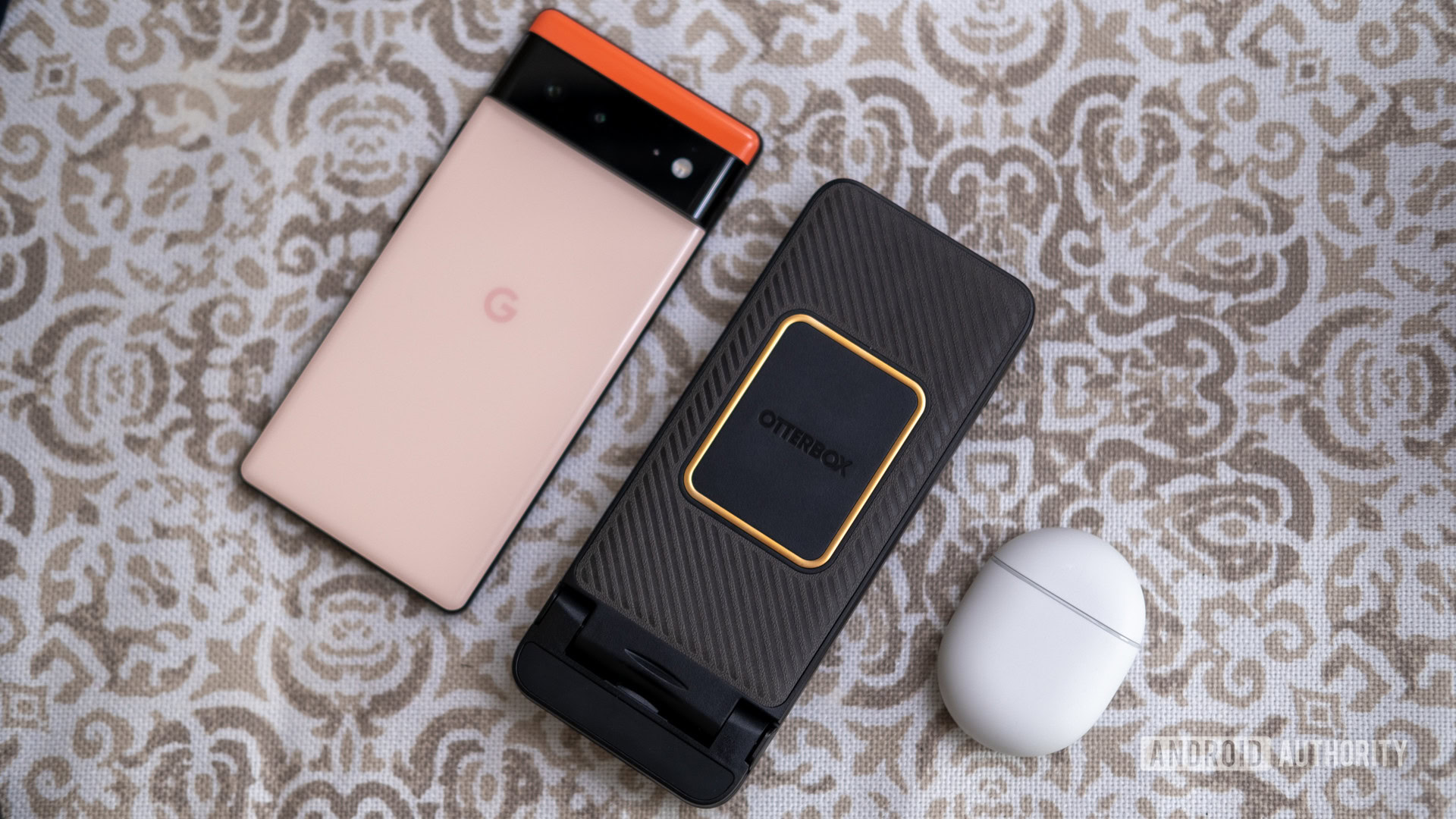
Officially, the Google Pixel Buds Pro earbuds last seven hours with noise canceling turned on. Only using noise canceling nets an extra 13 hours of battery from the case. To stretch the battery life out, turn ANC off. This gets you 11 hours of playtime from the Buds Pro. Keeping ANC off provides an extra 20 hours from the case. The Pixel Buds A-Series earbuds last five hours on a single charge, and the case provides an extra 19 hours of battery.
The Pixel Buds Pro and Pixel Buds A-Series cases can both fast charge their earbuds. Five minutes of charging yields 60 minutes of listening time with the A-Series and the Pixel Buds Pro (ANC on).
When testing the Pixel Buds Pro and A-Series battery life, we subjected each set of buds to music peaking at 75dB (SPL). Here are the battery life results under those conditions:
- Google Pixel Buds Pro, ANC on: Seven hours, six minutes.
- Google Pixel Buds A-Series: Four hours, 44 minutes.
Google Pixel Buds Pro vs Pixel Buds A-Series: What’s the difference?
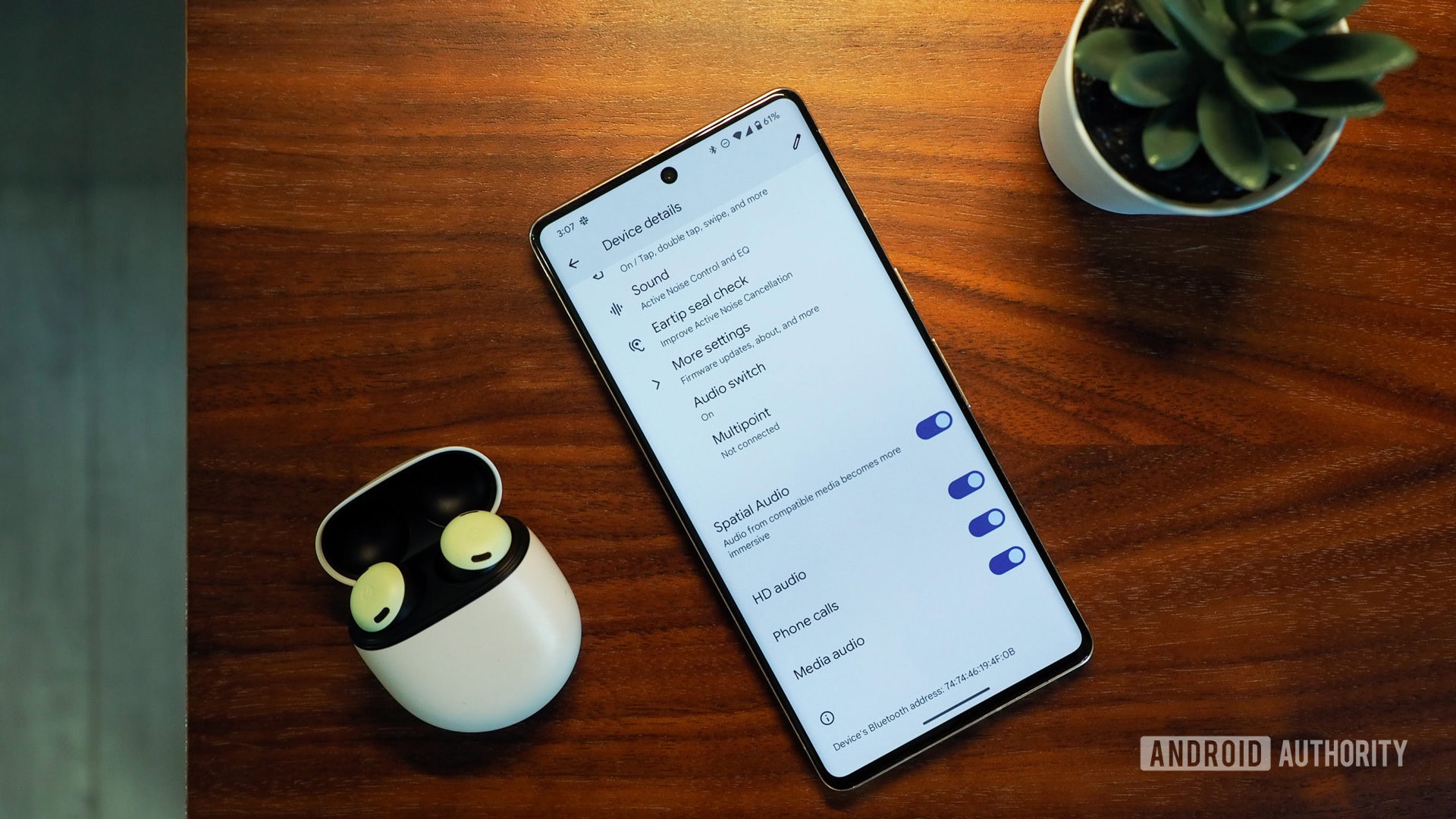
The Google Pixel Buds Pro are the belle of the ball. You get a more choice experience with noise canceling, spatial audio, and battery life. Comparing the Pixel Buds Pro to the Pixel Buds A-Series highlights that these earbuds target different audiences. Without ANC, the A-Series Pixel Buds are a more mundane, simplified product at a reasonable price.
Here are the main differences between the Google Pixel Buds Pro and Pixel Buds A-Series:
- Dimensions: The Pixel Buds Pro are larger than the Pixel Buds A-Series. The Pro earbuds are 23.7 x 22.3 x 22mm, and the case measures 63.2 x 50 x 25mm. The Google Pixel Buds A-Series buds are 29.3 x 20.7 x 17.5mm, and the case is 63 x 47 x 25mm.
- Battery life: According to Google’s specs, the Google Pixel Buds Pro last seven hours with ANC on, and 11 hours with ANC off. With ANC on the entire time, the Pro case provides an extra 13 hours of battery. The case will provide an extra 20 hours of battery life with ANC off. The Pixel Buds A-Series have a five-hour battery life, with 19 extra hours from the case.
- Sound quality: The Google Pixel Buds Pro have a more pleasing default sound than the Pixel Buds A-Series. The latter severely under-emphasizes sub-bass, bass, and low-midrange frequencies. Turning the Bass Boost EQ on with the A-Series makes them sound better than the Pixel Buds Pro.
- Custom EQ: With an update, Google added a custom EQ to the Pixel Buds Pro. You cannot customize the sound of the A-Series without downloading a third-party EQ app.
- Isolation: To block out the most noise, get the noise canceling Google Pixel Buds Pro over the A-Series. The Pixel Buds A-Series block out some background noise but do little to filter out low frequencies like an old A/C unit or a windy day.
- Spatial audio with head tracking: Pairing the Google Pixel Buds Pro to a Pixel 6 series or Pixel 7 series phone unlocks spatial audio with head tracking. You need to make sure the content is compatible, but it makes videos sound more engaging. The Pixel Buds A-Series lack the sensors required for spatial audio and head tracking.
What are some good Google Pixel Buds Pro and A-Series alternatives?
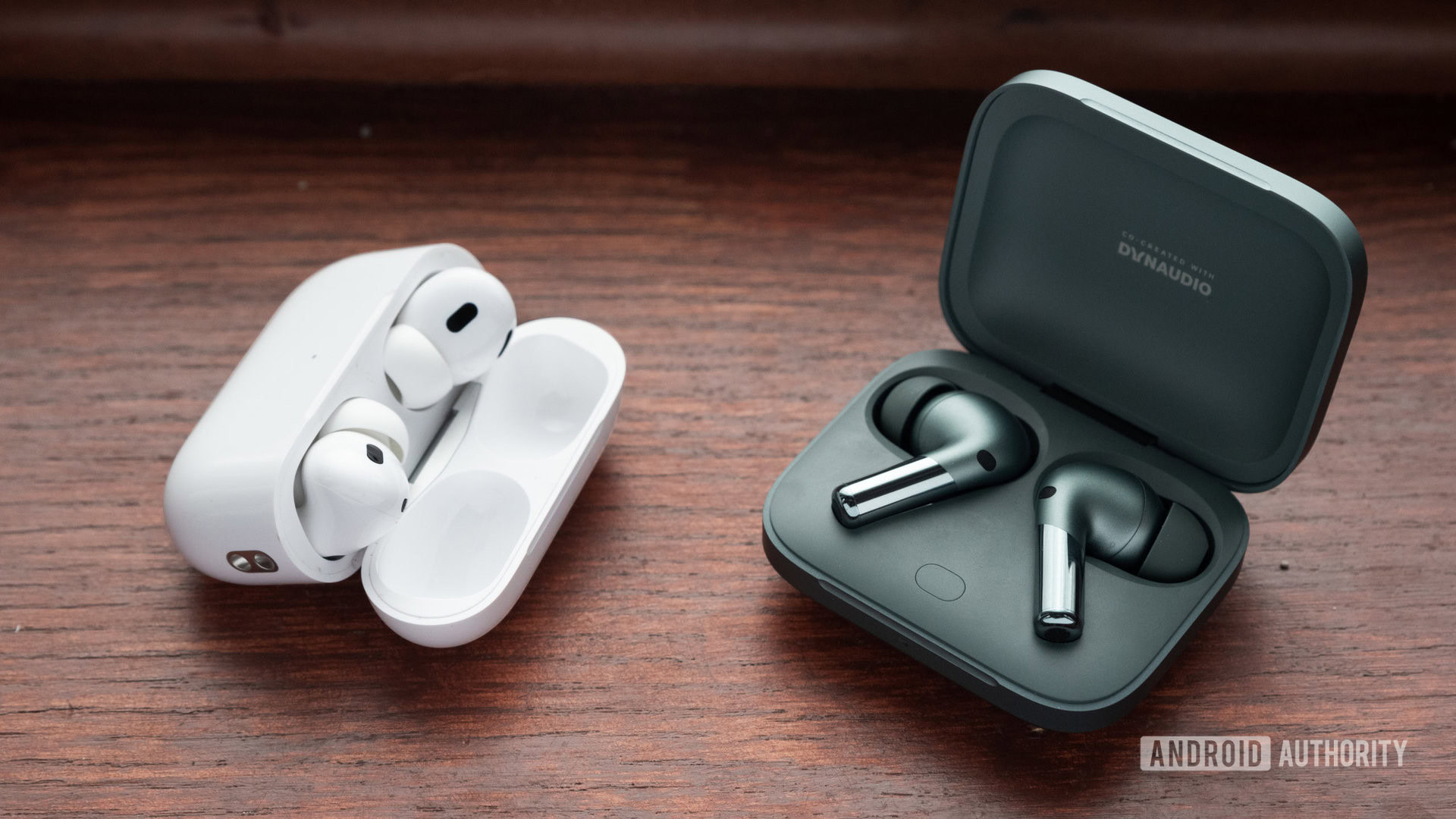
The Google Pixel Buds Pro and Pixel Buds A-Series are great earbuds, but they aren’t for everyone. If you want similar features from a different brand, check out our favorite Google Pixel Buds alternatives below.
Google Pixel Buds Pro alternatives
- Sony WF-1000XM4 ($278 at Amazon): The Sony WF-1000XM4 have something for everyone, making them the best all-around earbuds. You can enjoy personalized Sony 360 Audio from any device, including iPhones, and the rest of the app’s features are OS-agnostic too. Sound customization and mode choices are ready in the app. Sony’s hardware is great too. A matte plastic feels premium, and the IPX4 rating will be a relief to athletes. Sony also uses premium memory foam ear tips for a comfortable fit and top-notch isolation.
- Samsung Galaxy Buds 2 Pro ($179 at Amazon): The Galaxy Buds are the best for Samsung phone owners. Those with Samsung devices can use these buds for automatic device switching. We give Samsung props for its excellent ANC that outperforms the Sony WF-1000XM4 when it comes to those pesky low frequencies. Although you can’t use these for swimming, they will survive a dip in the pool thanks to the IPX7 rating.
- OnePlus Buds Pro 2 ($149 at Amazon): OnePlus’ earbuds also work with spatial audio, but it’s currently limited to the OnePlus 11. Aside from that, the HeyMelody app offers identical features across operating systems and devices. Here, anyone can customize the EQ to their liking or choose from various presets. The earbuds have an impressive IP55 rating, so they can resist dust and water damage. The case is also IPX4 water-resistant.
- Sennheiser Momentum True Wireless 3 ($169 at Amazon): These earbuds may not have spatial audio, but they have some of the best noise canceling in the business. You can also create a custom sound profile and assign it to a location. Then, when the phone registers you’ve entered an assigned location, it will adjust the sound to your preset. In typical Sennheiser fashion, sound quality is excellent too. You can customize the sound in the app, but likely won’t feel compelled to.
- Apple AirPods Pro (2nd generation) ($239 at Amazon): If you own an iPhone, get the AirPods Pro 2 instead of the Google Pixel Buds Pro. Many of the Pixel Buds Pro’s features won’t work on iOS. You can get a similar feature set from the AirPods Pro 2, including ANC, spatial audio, and more.
Google Pixel Buds A-Series alternatives
- Jabra Elite 4 ($79 at Amazon): The Jabra Elite 4 cost $99 and feature active noise canceling. These compact earbuds are even more durable than Google’s, with an IP55 rating. When paired to an Android phone, you can use Spotify Tap. The Elite 4 even support multipoint connectivity, which you don’t get on the A-Series. Of course, you miss out on hands-free Google Assistant access.
- Sony WF-C500 ($98 at Amazon): Sony’s non-ANC earbuds sound great and have an IPX4 rating. Battery life is extremely impressive, and in our testing, they lasted just shy of 10 hours on a single charge. These earbuds cost $99 and often go on sale for less.
- Samsung Galaxy Buds 2 ($99 at Amazon): You’ll get good noise canceling out of these small earbuds and an IPX2 rating. With a touch of bass emphasis, the Galaxy Buds 2 sound great out of the box. Parking these to an Android phone grants access to a handful of Samsung’s EQ presets along with Find My Earbuds. These buds fit comfortably, but we wish they had removable ear wings.
- Beats Fit Pro ($159 at Amazon): Beats’ earbuds feature non-removable ear wings like the Pixel Buds A-Series. The Fit Pro are also like the Pixel Buds Pro, because they have noise canceling and spatial audio with head tracking. To use head tracking, you’ll need an iPhone. Regardless of your phone, you can appreciate the earbuds’ design and IPX4 rating. Unlike the Pixel Buds series, the Fit Pro use button controls to command playback and field calls.
Google Pixel Buds Pro vs Google Pixel Buds A-Series: Where to buy Google’s earbuds
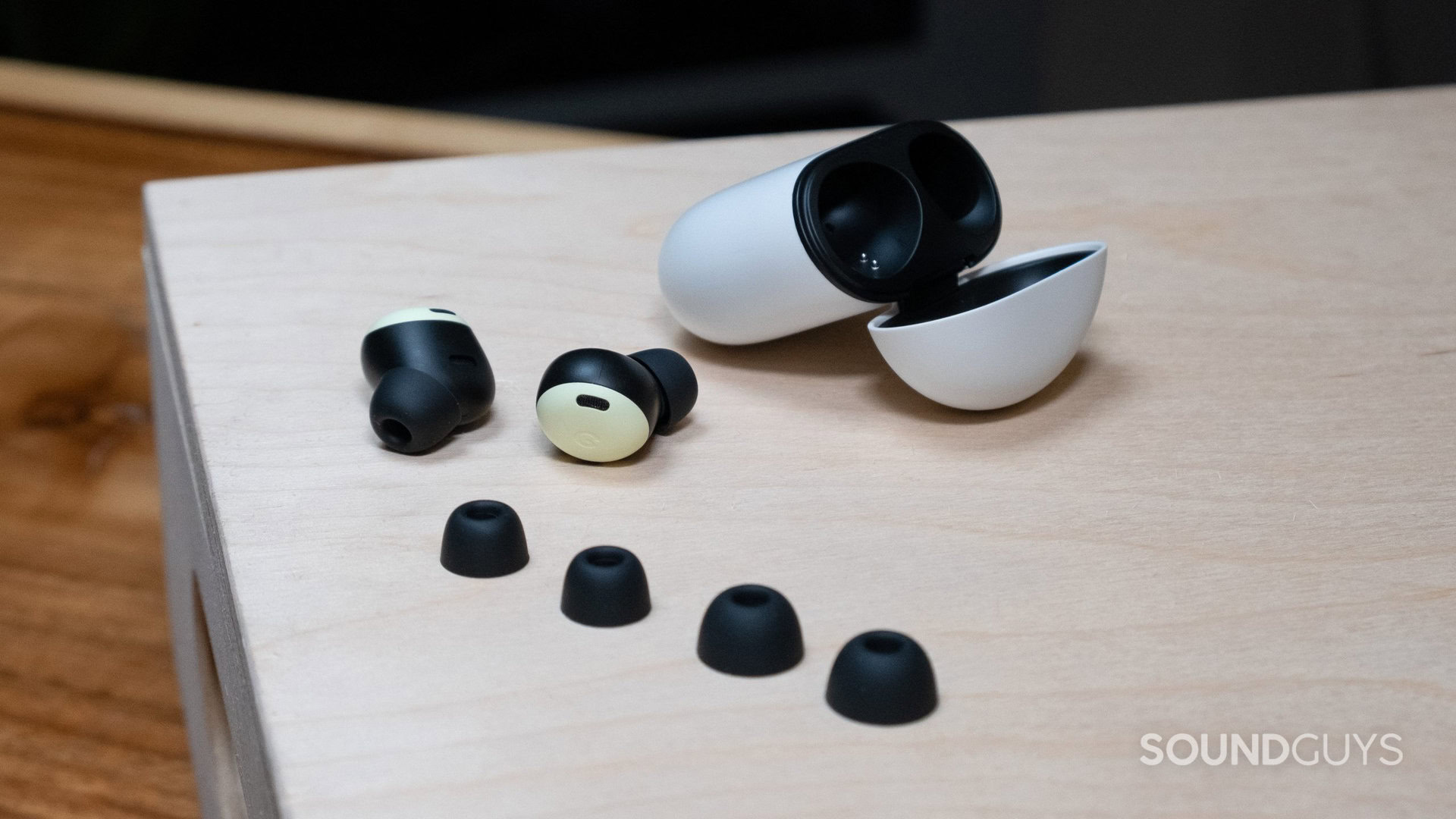
- Google Pixel Buds Pro: $199 / €219 / £179
- Google Pixel Buds A-Series: $99 / €99 / £99
The Google Pixel Buds Pro are $199, more than double the price of the $99 Google Pixel Buds A-Series. Purchasing the Pro model gives you great noise canceling, wireless charging, and spatial audio with head tracking.
On the other hand, listeners may want to save $100 with the Pixel Buds A-Series. These sound very good when you enable the Bass Boost EQ, and the buds fit more securely thanks to the ear wings. You don’t get wireless charging here, but the buds share the same IPX4 rating as the Pro model.
Google sells its Pixel Buds Pro and Pixel Buds A-Series in 16 countries, including the US, UK, Australia, and Japan.

Android integration
Google Assistant features

Low price
Multiple fun colors
Top Pixel Buds questions and answers
The Google Pixel Buds A-Series and Pro earbuds have an IPX4 rating. This means the buds can resist water splashes from any direction. The Pixel Buds Pro case has an IPX2 rating, so it can resist water that hits it at a 15-degree angle or less. The Pixel Buds A-Series case is not water resistant.
If you have an Android phone, the Google Pixel Buds Pro are better than the AirPods Pro (2nd generation). You get many more features when pairing the Pixel Buds Pro to an Android phone than you do with the AirPods Pro 2 on Android. Google lets you customize the Pixel Buds Pro EQ and find your Pixel Buds on an Android device. When paired with a Pixel 6 or later, the Pixel Buds Pro also have spatial audio and head tracking capabilities.
Pairing the AirPods Pro 2 to an Android phone doesn’t give you many features. You can enable noise canceling and enjoy Apple’s Adaptive EQ but that’s kind of it. Similarly, iPhone owners won’t get much out of the Google Pixel Buds Pro. There’s no iOS Pixel Buds app. If you own an iPhone, we highly recommend the Apple AirPods Pro (2nd generation) or AirPods 3 if you like unsealed earbuds.
Yes, you can replace your Pixel Buds Pro case for $70 in the US. Replacing one Pixel Buds Pro earbud costs $70, and replacing a full set of the ear tips costs $12.
Google’s website doesn’t list a way to replace the case, but you can replace the Pixel Buds A-Series earbuds and ear tips. Replacing one Pixel Buds A-Series earbud costs $39, and replacing the ear tip set costs $8. We recommend reaching out to Google’s customer support to inquire about a Pixel Buds A-Series case replacement.
You can locate your Pixel Buds by emitting a sound through the earbuds or visualizing them on a map. See below:
- Open the Pixel buds app. From a Pixel phone, go to Settings > Connected devices then tap the settings cog icon next to the Pixel Buds.
- Select your Pixel Buds from the app.
- Scroll down and tap Find device.
- Tap Ring Left or Ring Right. Your earbuds must be in close enough proximity that they’re connected to your phone for this to work.
- To continue looking, tap Last known location.
- This will launch the Find My Device app.
- The app will show you where they were last connected to your phone on a map.